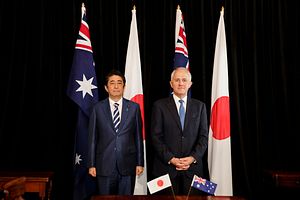Australian Prime Minister Malcolm Turnbull’s forthcoming visit to Japan looks set to provide a deepening of security ties between the two countries. It has been reported that Turnbull and his Japanese counterpart, Shinzo Abe, will sign a Visiting Forces Agreement (VFA) in order to enhance Australian-Japanese military cooperation. Discussions have been taking place over this matter since 2014.
A VFA is the legal document that defines the legal status of military personnel involved in any temporary military activities within the respective country’s territory. This includes joint military exercises and disaster relief missions. The VFA also provides exemptions on customs requirements for military equipment, and allows for the transportation of arms and hardware.
What makes this of special note is that it will be the first VFA Japan will sign (Japan has a distinct Status of Forces Agreement with the United States), providing a further signal that the Japanese government is seeking to test the boundaries of its pacifist constitution. Japan is also looking to sign a VFA with the United Kingdom, and the Nikkei Asian Review reported in mid-December that those two countries are planning to conduct joint military exercises in Japan later in 2018.
As of yet there are no reported plans for any joint military exercises between Australia and Japan; however, the VFA would not be signed without any further intentions, making it highly likely discussions on the subject will take place during Turnbull’s visit. Both countries are currently seeking a way to broaden their security relationships in light of continued uncertainty with the intentions of their mutual primary security partner, the United States. Although both will continue to remain reliant on Washington, hedging has become top priority for middle powers (constitutional restraints prevent Japan’s status as a great power)
Alongside their respective security relationships with the United States, Japan remains Australia’s second largest trading partner, and both countries continue to share a common set of values concerning the maintenance of a liberal international order. Both countries are strong supporters of the renamed Comprehensive and Progressive Trans Pacific Partnership (CPTPP), and during Turnbull’s visit he and Abe will also no doubt discuss ways to allay Canada’s concerns over the agreement (beyond the Ottawa-driven name change).
Australia’s decision in April 2016 to purchase its new submarine fleet from France, rather than what some analysts saw as a superior Japanese tender, would have been received as a slight in Tokyo. The deal would have been Japan’s first foray back into the business of exporting military hardware, again pushing the boundaries of Japan’s constitution. Beijing’s disapproval of the negotiations was deemed a factor in Australia pivoting toward the French proposal.
In this light, the signing of the VFA with Japan could be seen as Australia providing some respectful compensation to Japan for the submarine slight. It also provides some push back against China, letting Beijing know that although Chinese concerns may have been a factor in Australia’s decision not to purchase its new submarine fleet from Japan, Canberra will continue to pursue close ties with Tokyo.
However, the signing of the VFA does pose some questions for Australia’s position on Japan’s push toward normalization. Although a more muscular Japanese presence within the global sphere would seem an advantage to Australia, given the two countries’ shared values and commitment to liberal norms, the prospect comes with some serious repercussions. While current tensions on the Korean peninsula provide the impetus for Abe to make further strides toward Japanese normalization, the prospect has the potential to make Pyongyang increase its military posturing, spiraling into a classic security dilemma. Japan’s normalization would also deeply disturb China, adding an extra layer to regional tensions.
These concerns are paramount for Canberra, as Australia’s prosperity is bound to the region. Alongside Japan, China and South Korea are also among Australia’s largest trading partners (China first, South Korea fourth), making continued stability in northeast Asia essential to Australia’s national interests. But an inability to discern the commitment and direction of the United States has promoted Australia to seek other regional likeminded actors to maintain the status quo that is potentially threatened by China’s rise, and Japan remains a country of significant capability.
This leaves Australia needing to find a balance between pursuing closer security cooperation with Japan, and not encouraging any dramatic changes in Japan’s military structures that may unease the regional balance. It seems Australia has decided that smaller steps, like the signing of a VFA — potentially leading to joint military exercises — and more multilateral engagements, like the recently revived quadrilateral discussions with the United States and India, provide greater insurance against inflamed tensions than embracing Japanese desires to export military hardware.

































